|
|
|
Research Sudies
For complete information about each research study, please Click on it's Product Icon below.
|
Location-aware images: Using smart-phone capabilities to automate rich metadata. An industry-wide roundtable interview
|
 To enjoy and use a photo, you have to be able to find it. To enjoy and use a photo, you have to be able to find it.
Digital photos are computer files, and those files can contain more information than just the ones and zeroes that describe the image.
The camera-phone has significant potential as an intelligent imaging device, one that leverages its smart capabilities — calendar, address book, GPS and more — to annotate the pictures and videos it takes with highly valuable metadata that makes these images more valuable, whether for personal or business purposes.
The technology is here to make photography more useful and enjoyable — but the industry has yet to deliver the complete package.
What are the obstacles? Why hasn’t this capability come to market in a consumer-friendly package? When might we see progress on this front?
To find out, we spoke with:
- uLocate Communications, Walt Doyle, CEO.
- ShoZu, Jennifer Grenz, senior marketing director.
- Nokia, Andrew Elliott, director of experiences, Multimedia Business Group.
- David Burmester, associate director, Advanced MMS Services of Verizon Wireless.
- Gunar Penikis, senior product manager for Adobe Bridge and XMP.
- HP, Aaron Weiss, general manager, HP Snapfish Mobile Imaging.
- HP, Leo Blume, manager and senior architect, HP Snapfish Mobile Engineering.
- HP: Evan Smouse, CTO of digital photography and entertainment.
- Microsoft, Mike Calligaro, senior development lead.
- ComVu Media, William Mutual, CEO.
25 pages, Adobe PDF file.
|
|
| User-generated Visual Content: Understanding The Supply-Side Motivations |
 90 pages, 30 tables & charts
Today many Web-based businesses depend on content created by their audience — and yet they do not know what motivates the people who provide the crucial photos and videos, and how they are different from the more common viewers.
“User-generated Visual Content: – Understanding The Supply-Side Motivations” surveys hundreds of popular content creators and analyzes their reasons, compared and contrasted against a control group of average Web users.
The findings show what motivates the primary producers of user-generated content on popular websites, and how these people differ from the majority of Web viewers.
Future Image surveys almost 2,000 members of one of the top photo- and video-sharing websites. The answers to more than 20 questions are compared and contrasted in charts and graphs that show the differences between a control group of random users and a selection of the most productive, most popular content creators.
The full report questions content creators on:
- their levels of sharing activity
- their motivations and subject choices
- the need for attention and community
- the desire for making sales.
The report also includes extensive interviews with executives from Webshots, Simple Star, Corel, iStock, muvee, Filmloop, and Pure Digital, as well as a chronological compendium of two years of news articles on user-generated visual content from The Future Image Weekly Briefing information service.
|
|
| The Language of Mobile Imaging |
 The Language of Mobile Imaging – A Glossary of 1,405 Technical & Business Terms
Do you speak camera-phone? Are you left scratching your head when you read about camera-phone capabilities or next-generation networks? Let The Language of Mobile Imaging – A Glossary of 1,405 Technical & Business Terms help.
This unique resource contains more than 112,000 words explaining terms from wireless technology —personal, local, metro, and wide area network technologies, standards, and modulation schemes; from computer programming and information interchange standards; and from digital imaging — from optics, opto-mechanics, image sensors, image processing, flash and video lighting, to content formats, flash memory, and display technology, among others. It is designed to help executives from the digital imaging, telecommunications, information management, and content industries wade through the thicket of acronyms and technical jargon unavoidable in any discussion of wireless connectivity.
From the leading authority in the field, Future Image Inc, hosts of the Mobile Imaging Summit executive conferences and publishers of the Mobile Imaging Report continuous information service.
170 pages, 69 tables & figures
|
|
|
| Key Wireless Terms for Imaging Executives |
 This abridged edition of Future Image’s Mobile Imaging Glossary, consists of approximately 175 terms selected to help imaging industry executives, who are already familiar with imaging terminology and concepts, understand the brands, buzzwords, and tribal language of the wireless industry.
|
|
| Reinventing The Lens: Next-Gen Focus & Zoom Technology |
 Over the past ten years, photographic cameras have almost completely transitioned from silver halide film to electronic sensors. But the other key component — the lens — has remained largely unchanged... Until now. The mobile phone industry, with its huge demand for embedded cameras, is driving a broad set of new requirements for miniaturized, rugged, low-cost, low-power, high-performance lens and actuator combinations. As they come to market, the superior value proposition of those optical assemblies will threaten to displace traditional optics in cameras of all types. As a result, the business of designing and making lenses is undergoing its most fundamental upheaval since the Renaissance.
CMOS sensor developers have responded to consumer preferences for slimmer and slimmer handsets by shrinking their chips so that more pixels can be squeezed into an ever-smaller footprint. As pixel sizes shrink, standard fixed-focus lenses found on must camera-phones cannot pass the test of focusing light onto these tiny pixels. This presents a growing challenge — and an opportunity — to optical assembly designers and component suppliers to supply lens and actuator combinations that can provide both focus and zoom in smaller and smaller footprints.
“Reinventing the Lens: Next-Gen Focus & Zoom Technology,” a research study just published by Future Image, the leading independent center of expertise on the convergence of imaging, technology, and business, and host of the 6Sight® Future of Imaging conference, investigates the next generation of technologies being deployed to provide focus and zoom to the tiny cameras found in mobile phones and a wide variety of other applications such as medical research and robotics. “At our 6Sight conference last October, industry players were nearly unanimous in forecasting that top tier camera-phones would need auto-focus and optical zoom to meet consumer expectations. To deliver that DSC-like functionality, systems that can move or reshape lenses are required. The companies we analyze in this report are at the forefront of the drive to provide those capabilities.”
The 53-page report with 32 illustrations looks first at the changing requirements for mobile camera modules brought about by changing consumer preferences, including the latest developments in CMOS image sensors and explains why these changes require a new approach to the ‘traditional’ focus and zoom technology found in DSCs. Future Image conducted a survey and follow-up interviews with four of the leading vendors of next-generation focus and zoom technology: Artificial Muscle, Inc. (AMI), Nanomotion/Johnson Electric, New Scale Technologies, Inc. and Varioptic SA. All four vendors and their solutions are profiled. The study concludes with our analysis of the competing solutions and the outlook for their success.
|
Among the more than two-dozen topics covered by our vendor survey were the following:
|
|
2.
|
Technology Description |
|
3.
|
Advantages |
|
3.1.
|
Compared to traditional actuators |
|
3.2.
|
Compared to competing technologies |
|
3.3.
|
Compared to competing products that employ similar technology |
|
4.
|
Disadvantages |
|
4.1.
|
Compared to traditional actuators |
|
4.2.
|
Compared to competing technologies |
|
4.3.
|
Compared to competing products that employ similar technolog |
|
5.
|
Product Information |
|
5.6.
|
Speed — responsiveness, time in seconds to achieve focus (if applicable) |
|
5.7.
|
User experience — what, if any, differences will the end-user notice when using a camera-phone or camera that has your actuator vs. a standard, traditional actuator? |
|
5.11.
|
Manufacturing supply (can you meet the quantity and quality requirements of the CMA? |
|
5.12.
|
Track record (evidence of reputation, reliability, financial stability, etc.) |
|
|
| Reinventing The Lens: Software-Enhanced Optics |
|
 Shrinking Cameras Mandate Reinventing the Lens Shrinking Cameras Mandate Reinventing the Lens
New Future Image research study explores the challenging new landscape for optical designers and the innovative responses of the leading vendors of software-enhanced optics.
Over the past ten years, photographic cameras have almost completely transitioned from silver halide film to electronic sensors. But the other key component — the lens — has remained largely unchanged... Until now. The mobile phone industry, with its huge demand for embedded cameras, is driving a broad set of new requirements for miniaturized, rugged, low-cost, low-power, high-performance lenses. As they come to market, the superior value proposition of those lenses will threaten to displace traditional optics in cameras of all types. As a result, the business of designing and making lenses is undergoing its most fundamental upheaval since the Renaissance.
CMOS sensor developers have responded to consumer preferences for slimmer and slimmer handsets by shrinking their chips so that more pixels can be squeezed into an ever-smaller footprint. This presents a growing challenge to optics designers to supply lenses that can focus the light entering the camera down to a smaller and smaller spot. As pixel sizes shrink, the standard fixed-focus lenses found on must camera-phones cannot meet this challenge. As they continue to shrink — sensors that will reach the market next year will have sub-2-micron pixels — even auto-focus lenses composed of traditional glass and plastic lenses will be inadequate.
“Reinventing the Lens: Software-enhanced Optics,” a research study just published by Future Image, the leading independent center of expertise on the convergence of imaging, technology, and business, and host of the 6Sight® Future of Imaging conference, indicates that the combination of specially designed optical components and image processing techniques may offer the best solution to this daunting technical challenge. “We think it’s inescapable that ‘software-enhanced optics’ in one form or another will play a pivotal role in next generation camera-phones, in a wide range of capture devices for automotive, security, medical, and industrial applications, and even in ‘pure play’ camera optics,” said Tony Henning, Editor of the Future Image Mobile Imaging Report and author of the study. “The benefits of the technology are too numerous and too significant not to find traction in the value chain. The only question that remains is which one — or which ones — will find commercial success.”
The 41-page report with 21 illustrations looks first at the changing requirements for mobile camera modules brought about by changing consumer preferences, including the latest developments in CMOS image sensors and explains why these changes require a new approach to the optical components. The study then describes in general terms the process of co-designing the optics and image-processing components to optimize the image captured by the sensor and summarizes the unique benefits that result from this approach. Future Image conducted a survey and follow-up interviews with the three leading vendors of software-enhanced optics: CDM Optics Inc. (OmniVision Technology Inc.), Dblur Technologies Ltd., and DxO Labs. All three vendors and their solutions are profiled. The study concludes with our analysis of the competing solutions and the outlook for their success.
Among the more than two-dozen topics covered by our vendor survey were the following:
2. Technology Description
3. Advantages
3.1 Compared to traditional glass or plastic lenses
3.2 Compared to competing technologies
3.3 Compared to competing products that employ similar technology
4. Disadvantages
4.1 Compared to traditional glass or plastic lenses
4.2 Compared to competing technologies
4.3 Compared to competing products that employ similar technology
5. Product Information
5.6 Speed — responsiveness, time in seconds to achieve focus (if applicable)
5.7 User experience — what, if any, differences will the end-user notice when using a camera-phone or camera that has your lens vs. a standard, traditional lens?
5.11 Manufacturing supply (can you meet the quantity and quality requirements of the CMA?)
5.12 Track record (evidence of reputation, reliability, financial stability, etc.)
|
|
Mobile Imaging and the Future of Bandwidth |
|
 The slow speeds of even the most advanced cellular networks make sending images from camera-phones a tedious process regardless of whether they are sent to a phone, an e-mail address, or a URL. When it takes more than a minute and sometimes as long as three minutes to share an image, users think twice before they hit the Send button. Therefore lack of bandwidth is a critical inhibitor to the widespread, mainstream adoption of Mobile Imaging, and to monetizing images within the mobile ecosystem. The slow speeds of even the most advanced cellular networks make sending images from camera-phones a tedious process regardless of whether they are sent to a phone, an e-mail address, or a URL. When it takes more than a minute and sometimes as long as three minutes to share an image, users think twice before they hit the Send button. Therefore lack of bandwidth is a critical inhibitor to the widespread, mainstream adoption of Mobile Imaging, and to monetizing images within the mobile ecosystem.
Furthermore, as the resolution offered by the typical camera-phone increases to match entry-level digital cameras, the problem is exacerbated. And 3G wireless networks won't help for uploading images from the mobile device, only for downloading content to it.
This report examines and compares the current state and the near-term roadmaps of the key Personal Area, Local Area, Metropolitan Area, and Wide Area network technologies, including: Infrared, Bluetooth, UWB, the many flavors of Wi-Fi, GSM and CDMA cellular technologies through HSDPA, HSUPA, and CDMA EV-DO Rev. A & B, UMTS-TDD, FLASH OFDM, and WiBro/WiMAX. It also examines the coming competition between cellular networks and the wireless internet as the medium of choice to send and receive images wirelessly, along with the implications for industry players.
43 pages, 32 tables & figures
|
Mobile Imaging - Inside the Camera-Phone Ecosystem |
|
 On October 11 and 12, 2005, 140 senior executives – CEOs, Vice Presidents, and Directors – from the photography, information processing, content and telecommunications companies leading the camera-phone revolution, came together at the exclusive Monterey Plaza Hotel and Spa for a day and a half of high-level brainstorming and networking hosted by Future Image and the International Imaging Industry Association. This report provides a comprehensive briefing on the opinions expressed and subsequent discussions. It includes the entire proceedings of the conference on video, in a five DVD set playable on a PC, Macintosh and/or a consumer DVD player. Key topics discussed include:
- State of the Industry
- Visionary Roundtable
- Goodbye Camera?
- The Imaging Living Room
- Storage and Management
- Beyond the 4X6
- The Future of Bandwidth
- New Technology Showcase
- Mobile Imaging Metrics
- Video - Mainstream At Last, or Still a Niche?
- Social Imaging: Where’s the Beef?
- Opportunities in Business Imaging – Grassroots or IT?
- Financial Roundtable
- Keynote Luncheon wiht Rick Smolan
5 DVDs
|
| |
| Kiosks and Print Services for Consumer Digital Photography |
 A burgeoning population of self-service print Kiosks and retail fulfillment services aim to provide digital camera users the same near-instant print gratification they expect from film cameras -before they fall into the non-printing habit of early digital camera adopters. But the outcome is hardly assured. - Are these offerings compelling enough in terms of price, quality and convenience? - Is the industry moving fast enough to deploy and generate awareness? - Can users who have grown accustomed to self-printing or no-printing- be reclaimed by the photofinishing industry? If so how? - What are users' motivations for printing, and can they be sustained? This report benchmarks these issues through vendor interviews regarding the status of their current rollout, their resulting observations, and their intentions going forward; and a user survey measuring awareness of service-based printing solutions, perceptions of their value proposition, and current and future behaviors. A burgeoning population of self-service print Kiosks and retail fulfillment services aim to provide digital camera users the same near-instant print gratification they expect from film cameras -before they fall into the non-printing habit of early digital camera adopters. But the outcome is hardly assured. - Are these offerings compelling enough in terms of price, quality and convenience? - Is the industry moving fast enough to deploy and generate awareness? - Can users who have grown accustomed to self-printing or no-printing- be reclaimed by the photofinishing industry? If so how? - What are users' motivations for printing, and can they be sustained? This report benchmarks these issues through vendor interviews regarding the status of their current rollout, their resulting observations, and their intentions going forward; and a user survey measuring awareness of service-based printing solutions, perceptions of their value proposition, and current and future behaviors.
|
|
Photoblogs – The New Paradigm for Photo Sharing
|
|
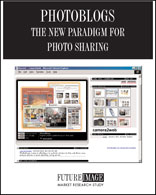 The report takes an in depth look at geometric growth of photoblogging, a new form of web-based photo sharing that has seen 10X month over month growth in content and users since the Spring of 2003. Based on extensive research of blogging and photoblogging services, technologies and applications, the report examines how photoblogs are changing the way digital photos are used and shared on the web, the role of key players already entering the segment such as AOL and Google, and the implications for various sectors of the imaging industry. It includes: The report takes an in depth look at geometric growth of photoblogging, a new form of web-based photo sharing that has seen 10X month over month growth in content and users since the Spring of 2003. Based on extensive research of blogging and photoblogging services, technologies and applications, the report examines how photoblogs are changing the way digital photos are used and shared on the web, the role of key players already entering the segment such as AOL and Google, and the implications for various sectors of the imaging industry. It includes:
- Definitions of blogs, photoblogs, moblogs, their core architecture features and how they differ from photo sharing web sites in both requirements and user experience - Profiles of the top ten vendors providing photoblogging software and hosting services - An inn-depth review of AOL’s new entry into the photoblogging market, Journals, and its integration with You’ve Got Pictures - A discussion of market segmentation and top applications for photoblogging - A review of the opportunities raised by photoblogging for vendors of: Image capture devices –digital cameras and camera-phones Desktop imaging software Imaging infrastructure products such as storage, DRM, content screening, etc. Mobile photo messaging software Stock photography Online photo sharing/printing services - An examination of the potential impact photoblogs will have on photo printing - A primer on RSS technology A listing of 18 vendors of software & services
40 pages with 26 tables and figures
|
|
Integrated Electronic Personal Photo Sharing (IEPPS)
|
|
 The study, entitled "Integrated Electronic Personal Photo Sharing – The Future of Consumer Photography" is 51 pages, with 23 tables and figures. The study, entitled "Integrated Electronic Personal Photo Sharing – The Future of Consumer Photography" is 51 pages, with 23 tables and figures.
The study’s methodology integrates behavioral analy*sis and technology analysis. It covers: - Recent sales performance, and forecasts for key related product categories. - The four key ways in which consumers "consume" their personal images, and the technology requirements for each. - A review of the performance and connectivity issues related to the display of digital images for Analog CRT Televisions, Digital CRT Televisions, LCD Televisions and HDTV Televisions. - An examination of current offerings in Media Servers, Media Receivers, and Media Center PCs. - An examination of wired and wireless home connectivity issues. - A discussion of image organization and user interface issues as they relate to the implementation of IEPPS systems. - A list of requirements for second generation IEPPS systems. - A five year unit and revenue forecast along with a discussion of opportunities and threats, particularly for providers of printing services. - A review of the offerings and strategies of the top ten players: Adobe Systems, Digeo, Eastman Kodak, Hewlett-Packard, Intel, Microsoft, Philips, Pioneer Electronics, Sony and Tivo, including interviews with key executives.
|
|
Megapixel Camera-Phones North America - A Comparative Overview
|
|
 Future Image recently introduced the Mobile Megapixel Monitor (MMM) as a component of its Mobile Imaging Report (MIR) continuous information service. The MMM is an online database accessible to MIR subscribers, which provides up to the minute reference information on the imaging capabilities of all camera-phones with megapixel or greater resolution currently for sale in North America, or announced for sale in the near term. To illustrate how the MMM can be used by market researchers, product planners and marketing and sales executives, this report presents the findings from a review and analysis of the database, which at publication date includes 17 models from 10 carriers. Database fields include Manufacturer, Model, Carrier, Price, Availability, Style, Dimensions, Sensor Type, Maximum Resolution, Optical Zoom Factor, Digital Zoom Factor, Flash, Video Capture Capabilities, Main Display, Sub-display, Camera Features, Removable Media, Connectivity Options, and Special Features. The report also includes a complete database listing, record-by-record and fully illustrated. Future Image recently introduced the Mobile Megapixel Monitor (MMM) as a component of its Mobile Imaging Report (MIR) continuous information service. The MMM is an online database accessible to MIR subscribers, which provides up to the minute reference information on the imaging capabilities of all camera-phones with megapixel or greater resolution currently for sale in North America, or announced for sale in the near term. To illustrate how the MMM can be used by market researchers, product planners and marketing and sales executives, this report presents the findings from a review and analysis of the database, which at publication date includes 17 models from 10 carriers. Database fields include Manufacturer, Model, Carrier, Price, Availability, Style, Dimensions, Sensor Type, Maximum Resolution, Optical Zoom Factor, Digital Zoom Factor, Flash, Video Capture Capabilities, Main Display, Sub-display, Camera Features, Removable Media, Connectivity Options, and Special Features. The report also includes a complete database listing, record-by-record and fully illustrated.
|
|
Turning Push Into Pull - Driving Clicks and Prints from Camera-Phones
|
|
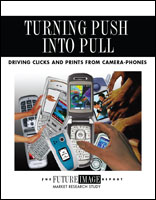 While sales growth of camera-phones in North America remains explosive, the market is currently driven by Push marketing strategies, namely subsidized sales of camera-phones by carriers. Lively discussions at the recent Mobile Imaging Summit North America (October 28 & 29, 2004) focused on what's necessary to switch the growth engine to customer Pull in order to grow the Mobile Imaging 'pie' for all concerned. Generating downstream revenues from images captured with the camera-phones is central to generating profits in areas beyond components and devices, and ultimately to the health of the entire ecosystem. This report summarizes discussions at the Summit and provides the recommendations of Future Image analysts concerning actions needed to generate regular use by the general public of the camera functions in their phones: evolving the devices to optimize them for image capture without compromising their communications capabilities; achieving image quality that meets consumer expectations within the specific constraints of camera-phones; and overcoming current bottlenecks to easy transfer of image data among devices in the imaging value chain. While sales growth of camera-phones in North America remains explosive, the market is currently driven by Push marketing strategies, namely subsidized sales of camera-phones by carriers. Lively discussions at the recent Mobile Imaging Summit North America (October 28 & 29, 2004) focused on what's necessary to switch the growth engine to customer Pull in order to grow the Mobile Imaging 'pie' for all concerned. Generating downstream revenues from images captured with the camera-phones is central to generating profits in areas beyond components and devices, and ultimately to the health of the entire ecosystem. This report summarizes discussions at the Summit and provides the recommendations of Future Image analysts concerning actions needed to generate regular use by the general public of the camera functions in their phones: evolving the devices to optimize them for image capture without compromising their communications capabilities; achieving image quality that meets consumer expectations within the specific constraints of camera-phones; and overcoming current bottlenecks to easy transfer of image data among devices in the imaging value chain.
|
|
Digital SLRs and the High-end Camera Market
|
|
 Digital camera sales continue to grow at a healthy pace, but profit margins are squeezed, retail space and mindshare are increasingly scarce for all but the biggest names, and overall volumes will increasingly be affected by competition from camera-phones. The key vendors are in an all-out battle to dominate higher-end system cameras which are not replaceable by camera-phones and benefit from follow-on sales such as additional lenses. This report includes: * A survey of camera enthusiasts examining their motivations, preferences and willingness to pay. * An roundtable with executives from the top camera vendors discussing technology, design, and marketing. * An overview of the cameras including reviews of key models, and charts contrasting cost; sensor resolution and sensitivity; and optics. Digital camera sales continue to grow at a healthy pace, but profit margins are squeezed, retail space and mindshare are increasingly scarce for all but the biggest names, and overall volumes will increasingly be affected by competition from camera-phones. The key vendors are in an all-out battle to dominate higher-end system cameras which are not replaceable by camera-phones and benefit from follow-on sales such as additional lenses. This report includes: * A survey of camera enthusiasts examining their motivations, preferences and willingness to pay. * An roundtable with executives from the top camera vendors discussing technology, design, and marketing. * An overview of the cameras including reviews of key models, and charts contrasting cost; sensor resolution and sensitivity; and optics.
200-plus pages, with more than 40 charts and graphs
|
|
Mobile Imaging - Profiting in the Camera-Phone Ecosystem
|
|
5 DVDs
On October 28 and 29, 2004, 140 senior executives – CEOs, Vice Presidents, and Directors – from the photography, information processing, content and telecommunications companies leading the camera-phone revolution, came together at the exclusive Monterey Plaza Hotel and Spa for a day and a half of high-level brainstorming and networking hosted by Future Image and the International Imaging Industry Association. This report provides a comprehensive briefing on the opinions expressed and subsequent discussions. It includes a white paper summary, plus as the entire proceedings of the conference on video, in a five DVD set playable on a PC, Macintosh and/or a consumer DVD player.
| Key topics discussed include: |
- State of the Industry
- Visionary Roundtable
- Mobile Imaging Infrastructure
- Mobile Imaging Devices
- Special Presentation The Wireless Device of the Future
- Hardware Enabling Technologies for Mobile Imaging Devices
- Software Enabling Technologies for Mobile Imaging Devices
- Emerging Technology Showcase
- Service-based Printing Opportunities
- Self Printing Opportunities
- Integration of Mobile Imaging with Enterprise IT
- Financial Roundtable – Where’s the Money?
- Non-Print Services and Applications Opportunities
- Opportunities in Content Delivery to Mobile Imaging Devices
|
|
|
Sending Photos Phone to Phone: Challenges & Opportunities
|
|
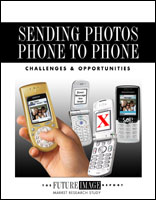 Many issues need to be resolved to encourage the adoption of mobile imaging in general and picture messaging in particular. Some have to do with the cellular networks, some have to do with mobile devices, and some have to do with the service providers - they need to simplify and reduce picture-messaging charges and they need to let us exchange pictures with anybody we want to, in particular with any other mobile phone, a capability generally referred to as Interoperability. Many issues need to be resolved to encourage the adoption of mobile imaging in general and picture messaging in particular. Some have to do with the cellular networks, some have to do with mobile devices, and some have to do with the service providers - they need to simplify and reduce picture-messaging charges and they need to let us exchange pictures with anybody we want to, in particular with any other mobile phone, a capability generally referred to as Interoperability.
All are important and all are being worked on, but the issue that currently shows the least progress is the last one - interoperability. Real, seamless, and universal inter-carrier picture messaging seems to be an ever-receding goal. There have been some announcements - even in North America - but some of the arrangements don't work at all and those that do generally leave a great deal to be desired. Through interviews with carriers and infrastructure vendors, this report explores the technical and business challenges that stand in the way of interoperability. It also describes some of the alternatives and workarounds being developed to fill the gap between customer expectations and the current reality.
|
|
4 x 6 Shoot-Out: Are Camera-Phones Ready To Make Consumer Prints?
|
|
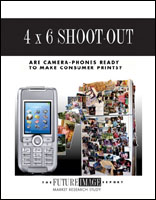 The purpose of this 36-page study, including 119 figures, charts, and tables, was to determine if currently available camera-phones are capable of delivering acceptable consumer prints and to assess how the images produced measure up to those produced by the most popular standalone consumer cameras. Prints from images obtained by camera-phones with resolutions of 640 x 480 (two models), one megapixel, and two megapixels were compared to those from a single use (OTUC) film camera, a single use (OTUC) digital camera, and digital point-and-shoot cameras of one-, two- and three-megapixel resolution. The purpose of this 36-page study, including 119 figures, charts, and tables, was to determine if currently available camera-phones are capable of delivering acceptable consumer prints and to assess how the images produced measure up to those produced by the most popular standalone consumer cameras. Prints from images obtained by camera-phones with resolutions of 640 x 480 (two models), one megapixel, and two megapixels were compared to those from a single use (OTUC) film camera, a single use (OTUC) digital camera, and digital point-and-shoot cameras of one-, two- and three-megapixel resolution.
Six test subjects, representative of standard consumer photo activities, were photographed: a house in full sunlight, an interior shop display, an outdoor portrait in bright open shade, an indoor portrait, a close-up of small objects, and an antique spice rack in dim interior lighting. Standard consumer 4 x 6-inch borderless glossy prints of all 54 test shots were made using three different methods — a home inkjet printer, thermo-autochrome equipment at a corner drug store kiosk, and an online service that uses a silver halide-based process. We used the prints from these various sources as the basis for our evaluation of the results. Prints were scored in four performance categories — sharpness/level of detail, color accuracy and saturation, compression/interpolation artifacts, and dynamic range, yielding overall quantitative scores for each device for each subject and for each performance dimension.
40-page study, including 119 figures, charts, and tables
A CD-ROM containing all the original images used to make the prints is also available.
|
|
Still and Video Camera Convergence
|
|
t ill and Video Camera Convergence — Pervasive Motion Capture and the Future of Consumer Imaging Digital cameras have long had the capability to capture motion clips – with such limited quality and capacity, however, that the feature was little more than a novelty. The latest digital still cameras by contrast record TV-quality video — full-screen and 30 frames per second, up to the capacity of the storage card. What does this mean for the photography industry? Is the long-heralded merger of still and motion cameras into a single multi-purpose device finally close at hand? Will users shift their behavior to capture more videos than stills — and, as a consequence, further reduce the number of prints they make? This report features a 15-page “round-table” style discussion of the issues with executives from Kodak, Nikon, Canon, HP, Fuji, Konica Minolta, Olympus, and Sony, covering: • Convergence — Now or Not; • Technology Enablers and Obstacles; • Manufacturer Motivations; • User Habits And Choices; and • Monetizing Video -Printing and Other Output The report also includes: - A table summarizing the video capture capabilities of twenty five leading digital camera models from Canon, Fuji, Kodak, Kyocera, Minolta, Nikon, Olympus, Pentax, Samsung, Sanyo and Sony - An overview of selected video CODECs – AVI, Motion JPEG, MPEG 1, 2 and 4, Mini DV and QuickTime - A discussion of the MPV standard for playback of digital video and stills on consumer DVDs - Perspectives on the retailer’s viewpoint; new paradigms for monetizing video and images, based on the value of content; and the impact of camera-phones on still/video convergence 42 pages of selected news stories on digital cameras and video excerpted from 2003 and 2004 coverage in the Future Image Weekly Briefing, the industry executives primary source for current trends and technology news. 73 pages, 13 Illustrations ill and Video Camera Convergence — Pervasive Motion Capture and the Future of Consumer Imaging Digital cameras have long had the capability to capture motion clips – with such limited quality and capacity, however, that the feature was little more than a novelty. The latest digital still cameras by contrast record TV-quality video — full-screen and 30 frames per second, up to the capacity of the storage card. What does this mean for the photography industry? Is the long-heralded merger of still and motion cameras into a single multi-purpose device finally close at hand? Will users shift their behavior to capture more videos than stills — and, as a consequence, further reduce the number of prints they make? This report features a 15-page “round-table” style discussion of the issues with executives from Kodak, Nikon, Canon, HP, Fuji, Konica Minolta, Olympus, and Sony, covering: • Convergence — Now or Not; • Technology Enablers and Obstacles; • Manufacturer Motivations; • User Habits And Choices; and • Monetizing Video -Printing and Other Output The report also includes: - A table summarizing the video capture capabilities of twenty five leading digital camera models from Canon, Fuji, Kodak, Kyocera, Minolta, Nikon, Olympus, Pentax, Samsung, Sanyo and Sony - An overview of selected video CODECs – AVI, Motion JPEG, MPEG 1, 2 and 4, Mini DV and QuickTime - A discussion of the MPV standard for playback of digital video and stills on consumer DVDs - Perspectives on the retailer’s viewpoint; new paradigms for monetizing video and images, based on the value of content; and the impact of camera-phones on still/video convergence 42 pages of selected news stories on digital cameras and video excerpted from 2003 and 2004 coverage in the Future Image Weekly Briefing, the industry executives primary source for current trends and technology news. 73 pages, 13 Illustrations
|
|
Digital Cameras: Strategies to Reach the Late Majority
|
|
 As purchases of digital cameras by early adopter and early majority consumers begin to slow, successful strategies to address the late majority audience become critical to continued sales success. This report compares and contrasts the approaches of five companies who have taken the early lead, each with different business goals and tactics: HP, Kodak, Pure Digital, Sound Vision and Sprint. The report includes: - A roundtable discussion in which senior executives of all five companies discuss the motivations and strengths of their respective strategies - In-depth profiles of Kodak�s camera dock based strategy; Sprint�s camera-phone initiative; Sound Vision�s TV-centric simplified camera and its marketing; and the platform and strategy behind Pure Digital�s single-use digital camera. - A comprehensive reference of digital camera-related announcements from January 2003 to January 2004 - Opinion and analysis from Future Image Inc. As purchases of digital cameras by early adopter and early majority consumers begin to slow, successful strategies to address the late majority audience become critical to continued sales success. This report compares and contrasts the approaches of five companies who have taken the early lead, each with different business goals and tactics: HP, Kodak, Pure Digital, Sound Vision and Sprint. The report includes: - A roundtable discussion in which senior executives of all five companies discuss the motivations and strengths of their respective strategies - In-depth profiles of Kodak�s camera dock based strategy; Sprint�s camera-phone initiative; Sound Vision�s TV-centric simplified camera and its marketing; and the platform and strategy behind Pure Digital�s single-use digital camera. - A comprehensive reference of digital camera-related announcements from January 2003 to January 2004 - Opinion and analysis from Future Image Inc.
96 pages
|
|
Will Camera-Phones Replace Digital Cameras?
|
|
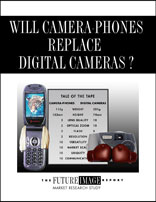 Camera-phones are on the verge of delivering the snapshot capabilities that people currently expect from single-use film cameras and entry-level digital cameras. The recent release of two-megapixel camera-phones by all three Japanese wireless carriers raises the question: Why buy a digital camera? Camera-phones are on the verge of delivering the snapshot capabilities that people currently expect from single-use film cameras and entry-level digital cameras. The recent release of two-megapixel camera-phones by all three Japanese wireless carriers raises the question: Why buy a digital camera?
“Will Camera-phones Replace Digital Cameras?” is based on an in-depth analysis of the performance characteristics of point-and-shoot digital cameras and camera-phones in more than 30 separate performance and value dimensions, both for current and soon-to-be-released models. Current and near-term capabilities and trends are considered. The 50 page study with 62 figures and charts includes forecasts for the impact of camera-phones on unit sales and dollar values of three categories of point-and-shoot cameras – one megapixel and under, two megapixel, and three megapixel, the current “sweet spot” for consumer cameras. Its key conclusions include: - Digital camera manufacturers are already beginning to feel the impact of camera-phone popularity in the Japanese domestic market, where there are more than 25 million camera-phones in use. - Over the study period 2003–2006, camera-phones will reduce the sales of digital cameras by 7.7 percent, for a total of 12.6 million fewer units shipped, and a decrease of more than $2.7 Billion in shipment value. - Less than two percent of camera-phone sales will be substitution sales, with the balance consisting entirely of incremental sales.
50 pages, 53 figures and charts
|
|
The Camera-Phone Phenomenon
|
|
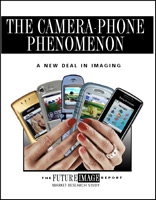 This report forecasts that worldwide sales of camera-phones will exceed those of digital cameras this year, and that megapixel quality camera-phones will be on the market within months, with two and three megapixel units close behind. It further states that the challenges to mass-market adoption of camera-phones in the U.S. - both business and technical - will be met within the next 12 months, noting that carriers such as Sprint, T-Mobile, and AT&T have already been paving the way with television and print ads featuring picture messaging. Cell phone cameras include both camera-phones (cell phones with built-in cameras, the principal focus of the report) and camera attachments to cell phones (also covered). This report forecasts that worldwide sales of camera-phones will exceed those of digital cameras this year, and that megapixel quality camera-phones will be on the market within months, with two and three megapixel units close behind. It further states that the challenges to mass-market adoption of camera-phones in the U.S. - both business and technical - will be met within the next 12 months, noting that carriers such as Sprint, T-Mobile, and AT&T have already been paving the way with television and print ads featuring picture messaging. Cell phone cameras include both camera-phones (cell phones with built-in cameras, the principal focus of the report) and camera attachments to cell phones (also covered).
The "Camera-Phone Phenomenon" report forecasts that the challenges to mass-market adoption of camera-phones in the U.S. — both business and technical — will be met within the next 12 months. Carriers such as Sprint, T-Mobile, and AT&T have already been paving the way for months with television and print ads aimed at raising public awareness of picture messaging.
The 31-page report includes 24 figures, charts, and tables, and covers: - Comparative forecasts for sales of camera-phones and digital cameras - End-user feedback and usage patterns in the Asia/Pacific region - An analysis of technology issues and trends for next generation handsets, including sensor resolution, CMOS vs. CCD technology, and optics. - Geographical differences in market acceptance and a geographic breakdown of sales - Analysis of drivers and inhibitors in Japan, Korea, China, Western Europe, and the United States - Short and medium term prospects for the U.S. market - An analysis of business opportunities resulting from camera-phone sales, in the areas of print services, commercial content delivery, and infrastructure and content management services.
|
|